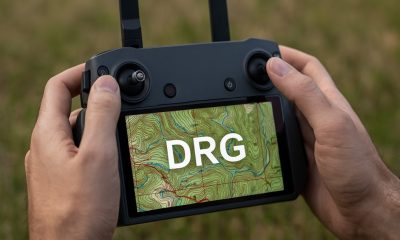- Acronym Guide
- AAM
- ABS
- AC
- ACAS
- ADS-B
- AFAC
- AGL
- AI
- AIM
- ALS
- AM
- AMA
- ANSP
- AOI
- APPI
- AUV
- AUVSI
- ARPAS-UK
- ASTM
- ATC
- BVLOS
- CAA
- CAAC
- CAB
- CASA
- CATT
- CBO
- CBR
- CBRN
- CDMA
- CDR
- CFR
- CIR
- COA
- COMINT
- CORS
- COTP
- COTR
- CPTED
- CV
- C2
- DAA
- DEM
- DFI
- DFS
- DGCA
- DHS
- DOD
- DPA
- DPEs
- DRG
- DRO
- DSM
- DSMX
- DSP
- DSSS
- DTM
- EASA
- EFT
- EO
- EOD
- EO/IR
- ELINT
- EMI
- ESC
- EVLOS
- eVTOLs
- FAA
- FCC
- FCS
- FHSS
- FICCI
- FLIR
- FOB
- FOV
- FPS
- FPV
- GBDAA
- GCP
- GCS
- GDPR
- GML
- GNSS
- GPS
- GSD
- GVC
- HDR
- HOGE
- IACRA
- ICAO
- ICS
- IMU
- INS
- IR
- ISA
- ISR
- ITU
- JARUS
- LAAMS
- LAANC
- LAATM
- LAI
- LBA
- LIDAR
- LOS
- LSALT
- MAC
- MAVLink
- MLIT
- MMS
- MSL
- MTOM
- NDAA
- NCSL
- NFZ
- NIST
- NMEA
- NOTAM
- NPA
- NPRM
- NTIA
- OBIA
- OEM
- OFDM
- OOP
- PASM
- PAV
- PCV
- PdM
- PEC
- PIC
- PID
- PIPL
- PLD
- PM
- PN
- PPK
- PPS
- PSM
- PWM
- UAM
- UAOP
- UAS
- UASTM
- UAV
- UCAVs
- UHD
- UHF
- USV
- UTM
- RAIM
- RCC
- RCS
- RFI
- ReOC
- RePL
- RMS
- ROI
- RPAS
- RPC
- RTH
- RTK
- SaR
- SAR
- SARP
- SBAS
- S.Bus
- SBIR
- SEDENA
- SfM
- SFOC
- SIGINT
- SLAM
- SMS
- SORA
- STANAG
- STTR
- sUAS
- TCAS
- TCCA
- TFR
- TIN
- TOF
- TP
- TPS
- TSA
- VHF
- VLOS
- VTOL
Drone Acronyms
What is PEC (Pulsed Eddy Current)?
By
Jacob StonerTable Of Contents

Definition
Pulsed Eddy Current (PEC) is a non-destructive testing (NDT) technique used to detect flaws, measure thickness, and assess corrosion in conductive materials without requiring direct contact. PEC works by generating a pulsed magnetic field in a conductive material, which induces eddy currents. Variations in these eddy currents are analyzed to detect anomalies, such as cracks or areas of corrosion. PEC is particularly effective for inspecting structures with coatings, insulation, or other barriers.
Usage
In the drone industry, PEC is increasingly used in applications requiring aerial inspection of conductive materials, such as pipelines, storage tanks, and other metal structures. PEC-equipped drones can perform inspections in hard-to-reach or hazardous areas, offering a safer and more efficient alternative to traditional manual inspection methods. The technology enables precise and reliable data collection, even in conditions where traditional eddy current testing might be less effective.
Relevance to the Industry
PEC provides a critical tool for industries that rely on metal infrastructure, such as oil and gas, construction, and power generation. Drones equipped with PEC sensors can quickly survey large areas, detect corrosion under insulation (CUI), and identify structural defects without the need for scaffolding or manual access. This capability reduces downtime, improves worker safety, and enhances the accuracy of maintenance planning.
How Does Pulsed Eddy Current (PEC) Work?
Principles of Eddy Currents:
- Generating Magnetic Fields:
- Pulsed Magnetic Field: Pulsed Eddy Current (PEC) testing involves generating a pulsed magnetic field using a coil placed near a conductive material. This magnetic pulse creates a transient magnetic field that induces electrical currents, known as eddy currents, within the material.
- Eddy Currents in Conductive Materials: These eddy currents circulate within the material, forming loops that are influenced by the material’s properties, such as conductivity, thickness, and the presence of defects like cracks or corrosion. The behavior of these currents provides insights into the material’s condition.
- Interaction with Material Properties:
- Changes in Eddy Current Flow: When the eddy currents encounter an anomaly, such as corrosion, a crack, or a change in thickness, the flow of the currents is disrupted. This results in changes to the magnetic field surrounding the material.
- Detecting Variations: Sensors in the PEC system detect these variations in the magnetic field. The changes are then analyzed to determine the location, size, and nature of the anomaly.
Pulsed Eddy Current Process:
- Pulsed Signal Characteristics:
- Time-Domain Analysis: PEC uses pulsed signals, rather than continuous waves, which allows for deeper penetration into the material. The decay of the eddy currents over time is analyzed, providing information about the layers beneath the surface.
- Signal Decay Patterns: The rate at which the eddy currents decay depends on the material’s properties and any defects present. For example, areas with corrosion or reduced thickness will exhibit faster decay rates compared to intact areas.
- Inspection Through Coatings and Insulation:
- Non-Contact Measurement: PEC can inspect materials through coatings, paint, or insulation because the pulsed magnetic field penetrates these barriers without requiring direct contact. This capability makes PEC particularly useful for inspecting pipelines, storage tanks, and other structures covered by protective layers.
- Corrosion Under Insulation (CUI): PEC is highly effective at detecting corrosion under insulation, where traditional inspection methods would require the removal of the insulating material, significantly increasing time and cost.
Applications in Drone Inspections:
- Drone-Mounted PEC Systems:
- Integration with UAVs: PEC sensors can be mounted on drones, enabling aerial inspections of conductive materials in hard-to-reach or hazardous locations. The non-contact nature of PEC allows drones to inspect structures like pipelines, bridges, and storage tanks without the need for scaffolding or manual access.
- Real-Time Data Collection: Drone-mounted PEC systems transmit inspection data in real-time to ground stations, allowing operators to immediately assess the condition of the inspected area and make informed decisions.
- Enhanced Efficiency and Safety:
- Reduced Downtime: PEC enables fast and efficient inspections without requiring the removal of coatings or insulation, reducing downtime for critical infrastructure. This is especially valuable in industries like oil and gas, where minimizing operational disruptions is crucial.
- Improved Worker Safety: By using drones equipped with PEC, operators can perform inspections in hazardous environments, such as high altitudes or areas with toxic chemicals, without exposing workers to unnecessary risks.
Data Analysis and Interpretation:
- Quantifying Material Thickness:
- Wall Thickness Measurement: PEC provides accurate measurements of material thickness, even for layered structures. By analyzing the decay rate of the eddy currents, the system calculates the remaining thickness of the material, helping identify areas that require repair or replacement.
- Detection of Hidden Defects: PEC can detect flaws that are not visible from the surface, such as corrosion under insulation or internal cracks, making it a valuable tool for predictive maintenance and structural integrity assessments.
- Visualization of Results:
- Heatmaps and Graphical Outputs: The results of PEC inspections are often presented as heatmaps or graphical plots that visually highlight areas with anomalies. This allows operators to quickly identify problem areas and prioritize maintenance efforts.
- Data Logging for Trend Analysis: PEC systems store inspection data for future reference, enabling operators to track changes over time and predict maintenance needs before critical failures occur.
By generating pulsed magnetic fields and analyzing the behavior of induced eddy currents, Pulsed Eddy Current (PEC) technology enables non-contact, non-destructive inspections of conductive materials. When integrated with drones, PEC provides an efficient and safe solution for detecting corrosion, measuring thickness, and identifying structural flaws in hard-to-reach areas.
Example in Use
“The drone’s pulsed eddy current (PEC) sensor detected corrosion under the insulated surface of a storage tank, enabling targeted maintenance without removing the insulation.”
Frequently Asked Questions about PEC (Pulsed Eddy Current)
1. How does Pulsed Eddy Current differ from traditional eddy current testing?
Answer: Pulsed Eddy Current uses pulsed magnetic fields, allowing it to:
- Inspect through coatings, insulation, or other barriers.
- Cover larger areas with less precise positioning compared to traditional eddy current testing.
- Provide more accurate measurements of wall thickness in layered materials.
2. What materials can PEC inspect?
Answer: Pulsed Eddy Current is ideal for inspecting:
- Metals: Particularly conductive materials like steel and aluminum.
- Coated or Insulated Surfaces: It can detect flaws and corrosion without removing coatings, paint, or insulation.
3. Why is PEC important for drone inspections?
Answer: Pulsed Eddy Current enables drones to:
- Perform non-contact inspections in hazardous or hard-to-reach areas.
- Quickly identify structural issues in pipelines, tanks, or bridges.
- Reduce the time, cost, and risk associated with traditional manual inspections.
For examples of these acronyms visit our Industries page.
As the CEO of Flyeye.io, Jacob Stoner spearheads the company's operations with his extensive expertise in the drone industry. He is a licensed commercial drone operator in Canada, where he frequently conducts drone inspections. Jacob is a highly respected figure within his local drone community, where he indulges his passion for videography during his leisure time. Above all, Jacob's keen interest lies in the potential societal impact of drone technology advancements.











